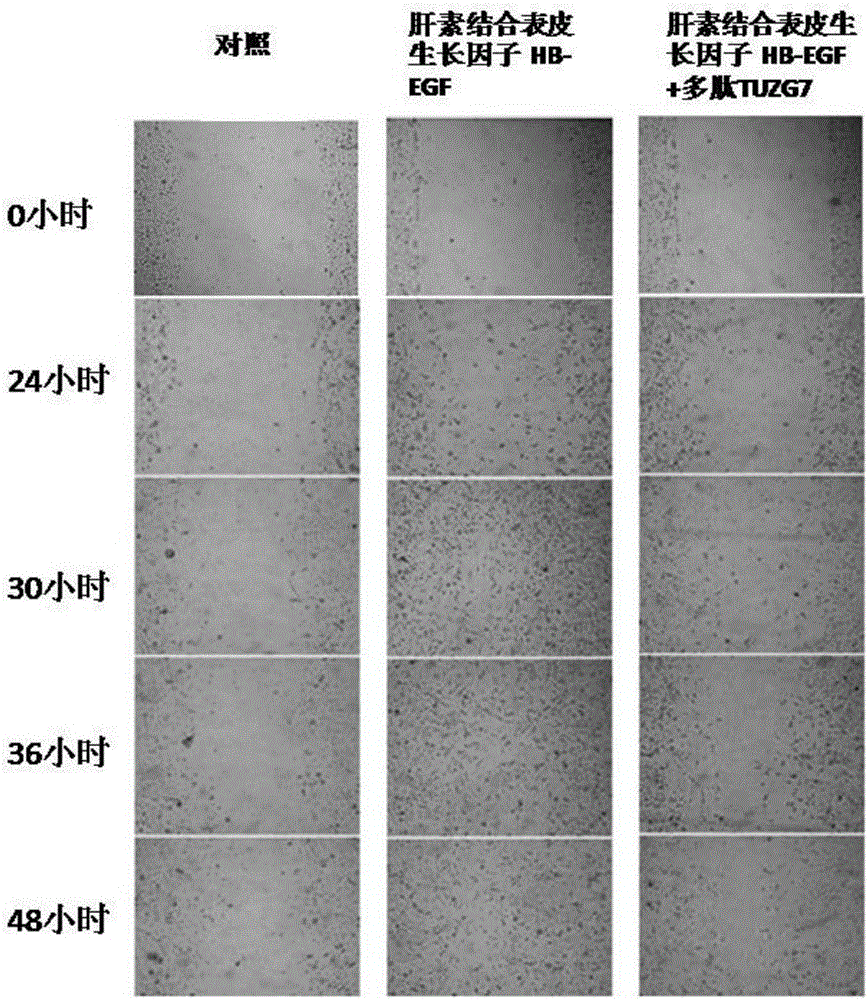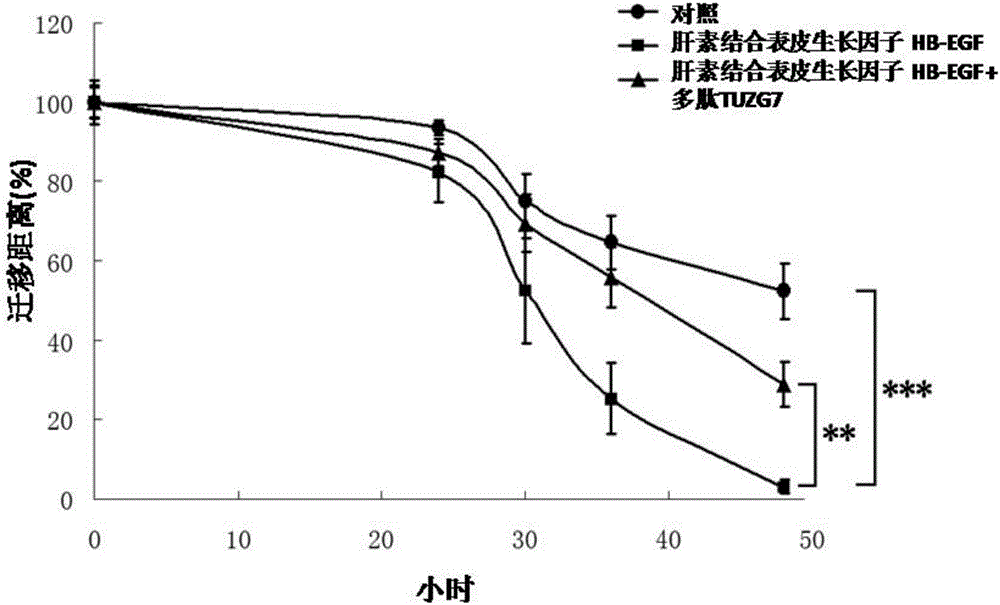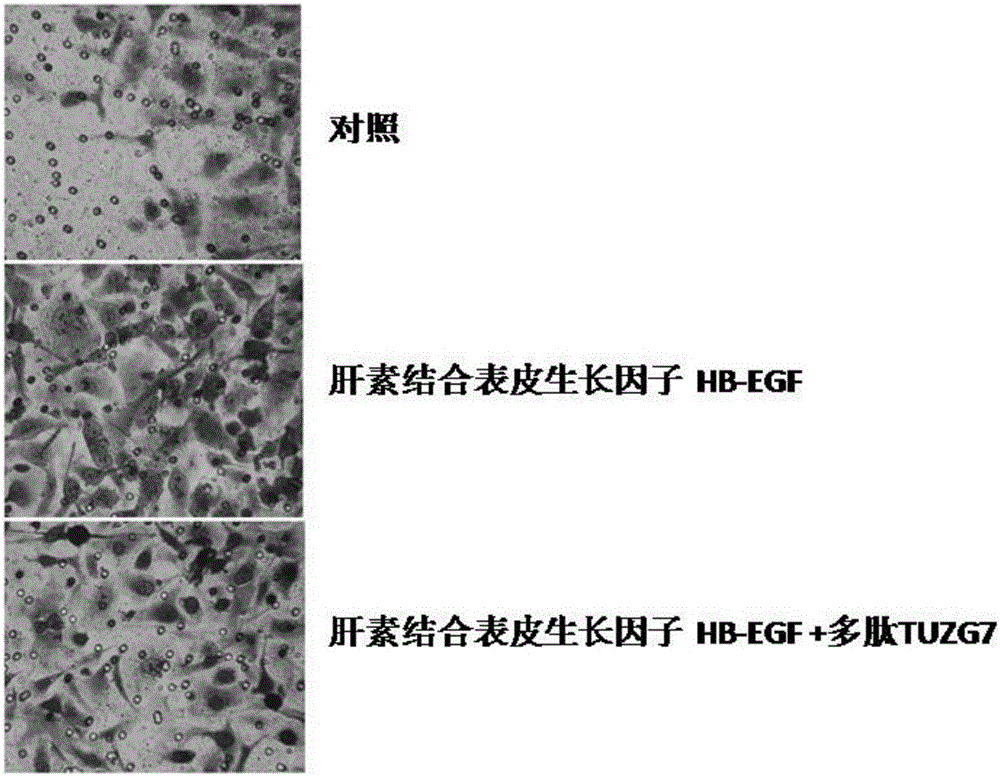Polypeptide with specificity inhibiting HB-EGF promoting tumor cell migration and infiltration
A polypeptide sequence, ovarian cancer cell technology, applied in the field of active polypeptide invention, can solve problems such as heavy workload and low screening efficiency, and achieve the effect of short polypeptide sequence, broad market and prospects, and high clinical value
- Summary
- Abstract
- Description
- Claims
- Application Information
AI Technical Summary
Problems solved by technology
Method used
Image
Examples
Embodiment 1
[0016] Example 1. Phage display panning for polypeptides that specifically bind to HB-EGF
[0017] Target molecule immobilization: 600 μl of target molecule HB-EGF (Pepro Tech Biological Company, USA) solution (dissolved in 0.1 M NaHCO 3 pH 8.6) was added to a six-well plate (NEST Sciences), placed on a shaker with gentle shaking, and incubated overnight at 4°C. The target molecule solution was removed and washed 6 times with TBST (50 mM Tris-HCl pH 7.5, 150 mM NaCl, 0.1% [v / v] Tween-20). Finally, block solution (0.1 M NaHCO 3 pH 8.6, 5 mg / ml BSA, 0.02% NaN 3 ) closed for 1 h.
[0018] Binding of phage random peptide library to target molecules: Remove the blocking solution and wash 10 times with TBST (0.1% [v / v] Tween-20). After the phage library or the amplified phage was diluted with TBST (0.1% [v / v] Tween-20), the titer of the phage was 10 9 ~10 11 In between, the diluted phage was added to the six-well plate to allow it to bind to the target molecule, and incubate...
Embodiment 2
[0026] Example 2. Cell culture and passage and cell scratch experiment
[0027] SKOV3 cells (American Type Culture Collection, USA) were cultured in RMPI-1640 (Life Technologies, USA) medium containing 10% fetal bovine serum and penicillin-streptomycin, and the growth status of the cells should be observed regularly every day and passaged in time.
[0028] Day 1: Seed boards.
[0029] from CO 2The subcultured SKOV3 cells were taken out of the incubator (Thermo Fisher Co., Ltd.), the original medium was discarded, and 2ml of PBS (Sinopharm Chemical Reagent Co., Ltd.) was added to wash, and the supernatant was sucked off with a Pasteur tube. Add 0.5 ml trypsin (Sigma-Aldrich (Shanghai) Trading Co., Ltd.) for digestion, transfer to a microcentrifuge tube (Haimen Leimin Experimental Equipment Business Department), centrifuge at 200 g for 5 min, and suck off the supernatant in the Pasteur tube . Pipette and mix 1 ml of RMPI-1640 medium containing 10% fetal bovine serum and penic...
Embodiment 3
[0032] Example 3. Cell Invasion Experiment
[0033] Day 1: ECM Matrigel (Sigma, USA) in a -20°C refrigerator was moved to a 4°C freezer and thawed overnight.
[0034] The next day: Pre-cool the ready-to-use 24-well plate, 10 μl pipette tip and Transwell chamber (Corning Life Sciences, USA), use pre-cooled fetal bovine serum-free medium and penicillin-streptomycin-containing medium and ECM matrigel 1 : 8 dilutions (in a pre-cooled microcentrifuge tube), after dilution, add 40 μl of ECM diluent to the Transwell chamber, and then put in 5% CO 2 , 37 ℃ cell culture incubator overnight.
[0035] Day 3: Transwell experiment.
[0036] from CO 2 Take out the subcultured SKOV3 cells from the incubator, add 1 ml of PBS, and suck off the supernatant with a Pasteur tube. Add 0.5 ml of trypsin for digestion, transfer to a microcentrifuge tube, centrifuge at 200 g for 5 min, aspirate the supernatant in the Pasteur tube, and add serum-free medium to resuspend the cells. Count with a hem...
PUM
 Login to View More
Login to View More Abstract
Description
Claims
Application Information
 Login to View More
Login to View More - R&D
- Intellectual Property
- Life Sciences
- Materials
- Tech Scout
- Unparalleled Data Quality
- Higher Quality Content
- 60% Fewer Hallucinations
Browse by: Latest US Patents, China's latest patents, Technical Efficacy Thesaurus, Application Domain, Technology Topic, Popular Technical Reports.
© 2025 PatSnap. All rights reserved.Legal|Privacy policy|Modern Slavery Act Transparency Statement|Sitemap|About US| Contact US: help@patsnap.com



